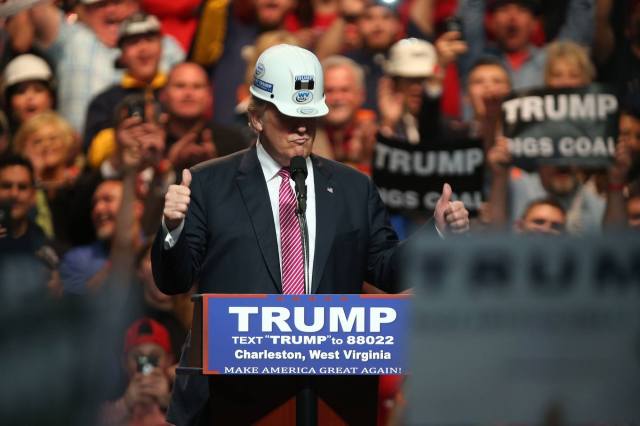Credit: Mark Lyons / Getty Images

“The Economy is raging, at an all time high, and is set to get even better. Jobs and wages up”, enthused Trump earlier this year. The President’s backers are citing the country’s low and dropping unemployment rate as evidence that he is fulfilling his promise to Make America Great Again. The national numbers certainly look encouraging. But is this success story universal? Are the flyover country communities that turned to Trump in 2016 more prosperous today?
The latest GDP growth figures are impressive, exceeding 4% in the second quarter, and the unemployment rate is now a paltry 3.9%. Wage growth, which has been low throughout most of the long recovery from the 2008-9 financial crash, has also started to pick up. And there is some evidence that wages are increasing especially quickly in traditional blue-collar occupations, like truck driving, that don’t require college degrees. Even the number of people receiving government disability insurance, who tend to be less educated and skilled, has started to decline after more than a decade of rapid growth.
No one can turn a giant economy around in one year, but these metrics suggest Trumpian economics is working. And yet, aggregate statistics mask as much as they reveal.
Trump became president on the strength of votes from White people without college degrees. He received particularly strong support from voters outside major metropolitan areas, in the small and medium-sized towns that have seen old-style manufacturing jobs leave over the past thirty years. Aggregate economic growth is great, but America has been growing wealthier overall for decades, even as these areas have moved backwards.
“Make America Great Again” was ultimately a promise that good jobs with good wages would return to these areas and benefit these people. Trump’s success or failure, therefore, should be judged not on the overall economic data, but on whether change is coming to these places.
And that’s when the success story loses some of its varnish. Only fifteen of America’s fifty states had job growth that exceeded the national average between March 2017 and March 2018 – and these are the same places that were growing quickly before Trump’s election places like California, Florida, Georgia, and Texas. Dig a bit deeper and you see some of the fastest job growth came in the progressive tech regions of Silicon Valley, the Microsoft-Amazon-dominated Seattle region, and counties around Denver, Houston, Dallas, Austin, and Atlanta. All citadels of the “new economy” that gave Hillary Clinton a much higher share of the vote than they gave Barack Obama.
So does this mean Trump has failed? Not quite. The story changes again when we look at wage growth. While some of the usual suspects also had above average wage growth, states like Georgia and New York drop off the list. They are replaced by blue-collar, Midwestern states like Vice President Mike Pence’s home state of Indiana, and Wisconsin, a Democratic-leaning state which was perhaps the most surprising Trump win.
This is consistent with the claim that wages for blue-collar workers are increasing particularly quickly, as these states have a higher share of these employees than the more white-collar-heavy economies of Manhattan and the San Francisco Bay Area. The county with the largest percentage wage growth in the country was in fact Peoria, Illinois (which voted for Hillary Clinton). In this old manufacturing-dominated county average weekly wages surged by nearly 24% last year as local area manufacturers strengthened. That sort of growth is exactly what Trump promised flyover America.
With that level of increase, Peoria is clearly an outlier, but when you look below state level data, there is evidence that both job and wage growth might indeed be picking up in the places in the American Midwest that made Trump president. Employment increased at a faster rate in the areas outside the big cities in three of the five midwestern states that shockingly switched from Obama to Trump.[1. Those five states are Iowa, Michigan, Ohio, Pennsylvania, and Wisconsin. The three states where employment growth in non-metro areas of those states exceeded the growth in the urban regions are Michigan, Pennsylvania, and Wisconsin.] Average weekly wages increased by more in non-metropolitan counties in one of the other states, Iowa, than in the cities; and wages increased faster in blue-collar and outstate Michigan than they did in high-income, suburban Oakland county. These are tentative signs that wealth is slowly being spread more widely.
In 1972, Chinese Premier Zhou Enlai famously said it was “too soon to say” when asked what the effects of the French Revolution were. While it turns out he was referring to the student protests of 1968, not the events of 1789, his comment is still instructive. Partisans for and against President Trump over the next year will be quick to assess whether he has kept his economic promises – but they will do so based on what will, at best, be incomplete data.
If four years are too soon to assess the effects of student protests, eighteen months is clearly too soon to determine whether flyover America is heading for better times. Voters will be judging Trump’s economic policy not by national-level metrics, but the direction of the economy in the towns and neighbourhoods in which they live. If politicians and pundits want to determine whether Trump is delivering for the people who put him in the White House, that is where they too should look.










Join the discussion
Join like minded readers that support our journalism by becoming a paid subscriber
To join the discussion in the comments, become a paid subscriber.
Join like minded readers that support our journalism, read unlimited articles and enjoy other subscriber-only benefits.
Subscribe